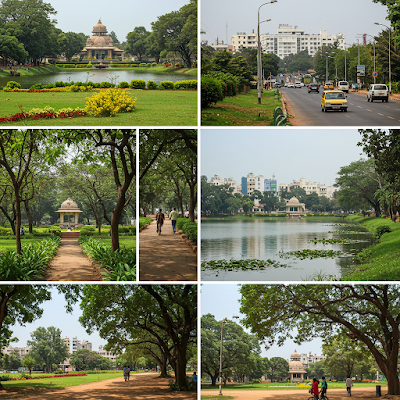 |
When we talk about "habitat" from the environment and ecology point of view, we mean the natural home where living things – plants, animals, even tiny bugs – find everything they need to survive.
So, what does the habitat look like in Bengaluru today?
Bengaluru, as I have been mentioning in my previous posts, has transformed rapidly. From the "Garden City" to a tech hub, the landscape has seen really big changes. This has had a direct impact on the natural habitats that once thrived here.
THE GREEN PATCHES
Many now refer to Bengaluru as a "concrete jungle". If it's not already one, many fear it's on its way to becoming one, very fast.
But let's not forget that Bengaluru still boasts some important green spaces.
Parks like Cubbon Park, Lalbagh Botanical Garden, and Bannerghatta National Park act as vital habitats. In my neighbourhood, there are four parks, and they are popular places for children to play and for people to go for their daily walking exercises.
They are also places for a variety of birds, insects, and small mammals.
For example, you might spot parakeets, mynas, squirrels, and even the occasional mongoose in these green lungs of the city.
Of course, these green spaces are under constant pressure. Encroachment, pollution, and the sheer volume of visitors can impact the delicate balance of these habitats.
LAKES: A MIXED STORY
Bengaluru was once known for its interconnected network of lakes. These water bodies are crucial habitats for fish, frogs, water birds like herons and kingfishers, and various aquatic plants.
Sadly, many of our lakes have suffered due to pollution from untreated sewage and industrial waste.
On a brighter note, there are ongoing efforts to rejuvenate some of these lakes. Initiatives focused on cleaning, desilting, and creating buffer zones are slowly helping to restore these vital habitats.
For instance, the restoration of Kaikondrahalli Lake has shown how community involvement can bring back biodiversity to urban water bodies. You can now see a variety of birdlife and even some fish species returning to such rejuvenated lakes.
IMPACT ON BIRD POPULATION
Studies by local ornithologists often highlight a decline in the diversity of certain bird species in core urban areas, likely due to habitat loss and increased noise and pollution.
However, green spaces and well-maintained lakes continue to support a richer variety. For example, sightings of migratory birds around restored lakes have been reported in recent years.
While the overall green cover has faced challenges, initiatives like tree planting drives by citizen groups and the forest department are making efforts to increase it.
In my neighbourhood, there is an ongoing initiative to restore a lake. (I will soon be writing about it.)
PROTECTING BIODIVERSITY
Understanding the habitat in our city helps us appreciate the biodiversity that still exists and the challenges it faces.
By supporting initiatives that protect and enhance green spaces and water bodies, and by making conscious choices in our daily lives (like reducing waste and supporting green initiatives), we can contribute to making Bengaluru a more livable place for both nature and ourselves.
(This post is part of the A to Z Challenge. The theme is environment)

Hari Om
ReplyDeleteIf there is one thing that was marked during the COVID lockdowns, it was how Nature could revive in our cities! Certainly here in the UK it was a beacon of distraction and hope. Mankind just had to stop being manic for a while and habitats revived and thrived.
Five years on, the lesson is forgotten... YAM xx
Another, interesting post that reminds us we need to care for our environment
ReplyDeletePeople may encroach on nature, but that can be pulled back too. It's harder, but it's doable.
ReplyDeleteI agree that we can do this. :D
DeleteHi Pradeep - I hope the residents will realise there is space up high in the concrete jungle - we've got beehives high on London's skyline, areas for some plants to survive ... there are niches that can be open to conservation ... we need all sorts. I'm sure now things are poor, that the powers that be and those that care will look to help Bengaluru conserve more - cheers ... you're highlighting aspects we all need to consider - thanks - Hilary
ReplyDeleteIt is good to see that some of the green spaces still exist despite the march of (so called) progress.
ReplyDelete